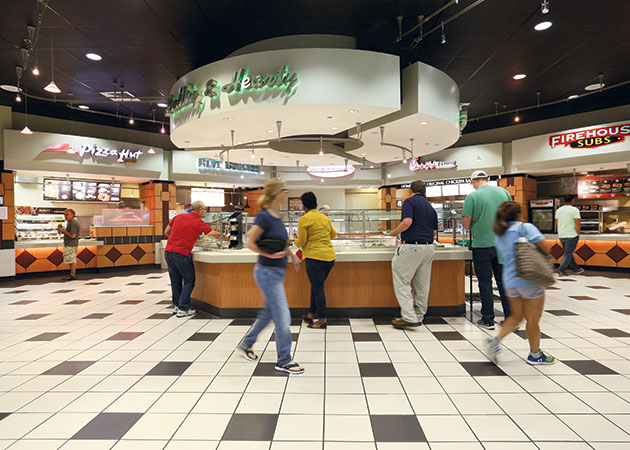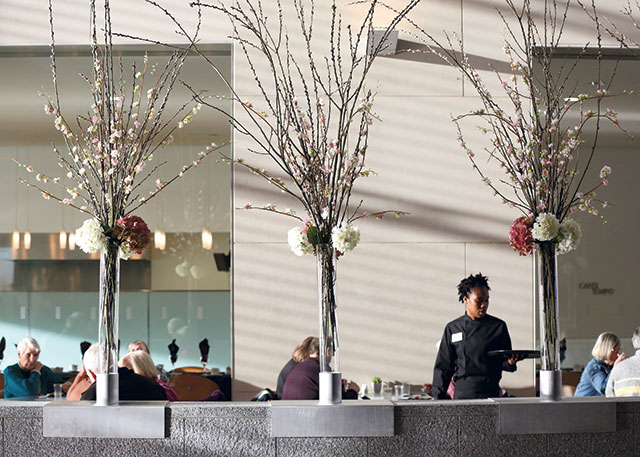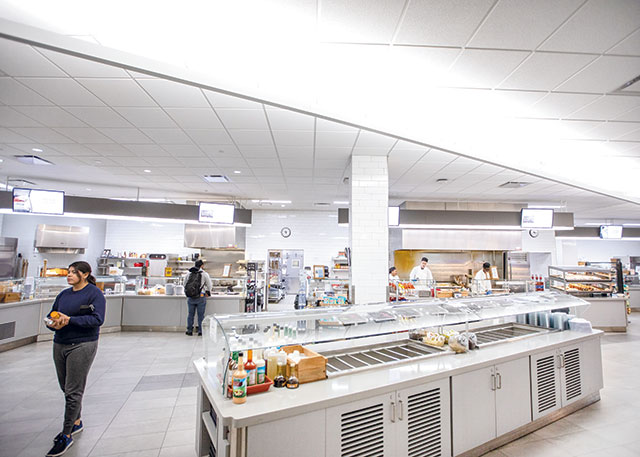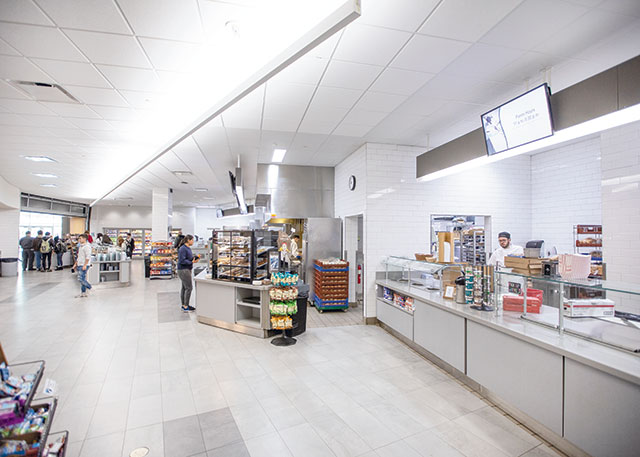A sometimes overlooked subset of college and university dining, two-year community colleges and technical schools are experiencing the same uncertainty right now as their four-year counterparts. But with COVID-19 fears and safety protocols dashing students’ hopes for a traditional residential campus experience, and with community colleges offering affordability, the ability to transfer credits, and the option of living at home until the dust settles, the segment could be a bright spot.
From a purely economic standpoint, history shows that when times are tough enrollment in community colleges rises. But the segment has also evolved to be much more competitive when it comes to campus culture and quality of life. That includes dining facilities and programs that can rival those of four-year universities — minus, in most cases, the residence hall element.
“Over the past several years we’ve seen a definite desire to upgrade foodservice operations compared to what was typical of this segment in the past,” notes Eric Goodrich, operations project manager at Rippe Associates in Minneapolis. “They want to be more competitive with four-year schools for first-year and full-time students. Now, those students may be much more likely to tap these feeder schools and go on to finish their degrees at a university post COVID-19.”
For those who do, rather than bare-bones programs of yesterday, they’ll now find vibrant food courts, branded restaurants, cook-to-order stations, specialty coffee bars, fine dining restaurants, bakeries and extensive catering programs, often with in-house culinary students contributing or running the operations. Here’s a look at two leading the way.
Johnson County Community College: Fast Tracking a Mobile App
“We have come a long way,” says Jay Glatz, director of dining services at Johnson County Community College in Overland Park, Kan., which touts a dining program that since 2006 has racked up a dozen awards for quality and innovation from the National Association of College & University Food Services. “Up until 2000, basically all we had was a little snack bar, coffee and vending.”
Renovations to JCCC’s student center over the past two decades saw the addition and subsequent expansion of a food court, which today includes Pizza Hut, Chick-fil-A, Firehouse Subs and Sushi with Gusto. There’s also a hot bar, the school’s own barbecue and burger concepts, and a salad bar. Next door, Market serves specialty coffees and smoothies, c-store items, pastries, snacks, salads and sandwiches, and features a daily Pop-Up Chef Station.
 Café Tempo, a popular special events venue at Johnson County Community College’s Nerman Museum of Contemporary Art, serves elevated breakfast and lunch fare.
Café Tempo, a popular special events venue at Johnson County Community College’s Nerman Museum of Contemporary Art, serves elevated breakfast and lunch fare.
JCCC dining also operates three specialty coffee and pastry bars across campus and Café Tempo at the Nerman Museum of Contemporary Art. That facility connects through a large atrium to a conference center that opened in 2007, a venue with seating for up to 300 that has contributed to tripling the catering department’s revenues, according to Glatz. “We do 60% to 70% of our business over in that area, between the museum and the conference center,” he says. “Plus, we cater all over campus. One locally based company brings in 100 to 200 employees for training every week.”
Plans for a celebration of JCCC’s 50th anniversary this spring, and a large annual fundraiser, were scrapped due to COVID-19 closures. Glatz feels catering, which was having a record year, may be the slowest component of the dining program to rebound. He also anticipates that self-serve salad and hot bars will not be available in the food court if students do return to campus in fall.
Meanwhile, he and his team continue to plan for social distancing and reduced-contact transactions. In June, with the college’s IT department, they began testing a mobile app for pre-ordering takeout items from Marketplace and some of the branded concepts in the food court. “That’s something that we’ll be fast-tracking and trying to build on, not just for fall but for the long term,” Glatz says.
 Café Tempo, a popular special events venue at Johnson County Community College’s Nerman Museum of Contemporary Art, serves elevated breakfast and lunch fare. Photos courtesy of Johnson County Community College, photo by Susan McSpadden
Café Tempo, a popular special events venue at Johnson County Community College’s Nerman Museum of Contemporary Art, serves elevated breakfast and lunch fare. Photos courtesy of Johnson County Community College, photo by Susan McSpadden
“We don’t have residence halls, which limits our dining program. But, in terms of the brands and the other services we offer, it’s very comparable what you’d find at a four-year school,” adds Marc McCann, executive chef at the 20,000-student college. “It really does help with how we can recruit new students and, given the economic downturn, we do expect we could see a surge in enrollment. In ’08–’09, our enrollment increased by about 15%.”
Madison College: Adapting an Efficiently Designed Cafeteria Remodel to Accommodate Social Distancing
Beginning in 2014, Madison College (then Madison Area Technical College) underwent a $31 million expansion and renovation of its flagship Truax campus, which today serves some 19,000 full- and part-time students. That project added new facilities for the school’s Culinary Arts program, as well as new dining and study lounge spaces.
Four years ago, the main servery was remodeled again, upgrading the modern, marketplace-style Atrium Cafe and improving efficiency, says Jason Walker, foodservice manager. Today, students can choose from concepts that include stone-hearth pizzas, deli sandwiches and paninis, international street foods, burgers and fries, and wellness-focused build-your-own bowls. A hot bar features home-style comfort foods, and a large salad bar anchors the cafe. Students in the college’s Baking and Decorative Arts program keep the operation’s large bakery cases filled with fresh-baked breads and pastries.
 Madison College’s main Atrium Cafe was remodeled four years ago to offer a modern, marketplace-style foodservice experience with a variety of cook-to-order, grab-and-go and self-serve options.
Madison College’s main Atrium Cafe was remodeled four years ago to offer a modern, marketplace-style foodservice experience with a variety of cook-to-order, grab-and-go and self-serve options.
Nearby, Atrium Coffee Shop features Starbuck’s coffee drinks, locally made ice creams, baked goods and a variety of grab-and go-items, while an additional second-floor kiosk serves Seattle’s Best Coffee beverages as well as bakery and snack items. Positioned off the culinary arts kitchen is Diane’s Delicious Diner, a simulated restaurant where Culinary Arts students gain experience in a full-service, upscale dining facility. The operation serves three-course, fixed-price meals focused on classical and international cooking styles to students, staff and the public.
“We’ve grown a lot and expanded our programs, both in terms of what we offer and in quality. We’ve built strong relationships with local vendors and incorporate local ingredients as much as possible,” Walker says. “Our sustainability programs have been really strong too. Over the past few years, we brought in a composter, a biodigester and implemented a big reusables program. We’re now doing a lot of research to find to-go packaging that meets our needs, as [the reusables program] will likely be put on hold.”
Before the campus closed due to COVID-19, Walker estimates the dining program averaged 3,000 transactions per day between 7:30 a.m. and 5:30 p.m. on school days. He’s now not sure what to expect for fall but is planning for various scenarios and working remotely on how to adapt facilities to meet safety requirements. All buildings on campus are locked until at least July 1.
 The cafeteria layout at Madison College will undergo some changes in response to the coronavirus pandemic as the facility looks to have fewer self-service options for fall.
The cafeteria layout at Madison College will undergo some changes in response to the coronavirus pandemic as the facility looks to have fewer self-service options for fall.
“When we remodeled the cafeteria, I designed it to be tight and efficient, both operationally and for getting people in and out quickly,” Walker says. “That was great before, but now we have to figure out social distancing. We’re looking at putting up temporary walls between the stations, dots on the floors, maybe rope stanchions. Our open seating area seats about 500, so we anticipate cutting that capacity to at least half. We’re trying to think about how we scale back menus too, but we just don’t have information yet on what to expect in terms of campus population, so it’s tough.”
Moves that are being considered include temporarily moving the always-busy panini grill station from the main cafe to the second-floor kiosk, closing down the salad bar and converting the international street food station to a tossed-to-order and prepackaged salad station.
“In general, we’re just trying to figure out how to spread things out and move to all full-service operations versus self-service. And we’re shifting to more controlled grab-and-go, bringing coolers that were out front to the back to reduce touch points,” Walker says. “The food aspect itself isn’t tough to change. It’s layout and operations that are more challenging when there’s so much uncertainty.”




